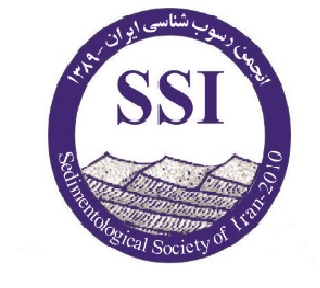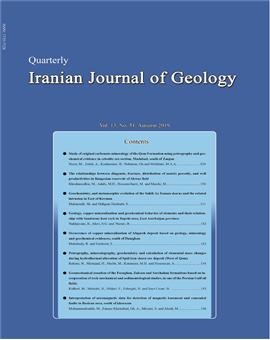Petrography, mineralography, geochemistry and calculation of elemental mass changes during hydrothermal alteration of Spid iron skarn ore deposit (West of Qom)
Subject Areas :Nima Rahimi 1 , حسن میرنژاد 2 , Maryam Sheibi 3 , Mohamad Hassan Karamian 4 , Alireza Hoseinyan 5
1 - University of Tehran
2 -
3 - Tehran University
4 - University of Tehran
5 - University of Tehran
Keywords: Argillic, Propylitic Mass changes, Hydrothermal alteration Spid Iron ore deposit. ,
Abstract :
Spid iron ore deposit is situated in the Urumieh-Dokhtar Magmatic Arc and is located 60 km West of Qom. The host rock varies in composition from diorite, quartz diorite to monzo diorite, and has been altered by the influence of hydrothermal fluids. The most important ore in the deposit is primary hematite (oligist) which is associated with pyrite, limonite, goethite, malachite and azurite. The most dominant alteration types in the Spid iron deposit are propylitic and argillic, identified by the presence of chlorite, epidote, carbonate, titanite, clay minerals and sericite. Grant Isocon method has been employed to study the behavior of elements and to calculate mass changes during hydrothermal alteration processes. The mass change calculations show that Fe2O3, MgO, K2O and LOI have been enriched, whereas P2O5, TiO2, Na2O and SiO2 have been depleted during propylitic alteration. The depletion of elements in this alteration points to the decomposition of primary minerals of the host rock, the presence CO2 rich solutions and the increase of fluid/rocks ratio during the development of the alteration system. During argillic alteration, SiO2, K2O, Na2O and P2O5 increased and TiO2, Fe2O3, MgO, CaO and LOI decreased. The increase in Na in this zone can be ascribed to the acidification of the plagioclase and its albitization, and the reduction of Fe and Mg results from the alteration of ferro-magnesin minerals such as amphibole, and the release of Fe in alterative solutions and outflow from the environment. Chemical index of alteration calculated for propylitic and argillic alteration zones are equal to 58.76 and 55.94 percent respectively, suggesting that propylitic alteration was more intense in the Spid ore deposit.

